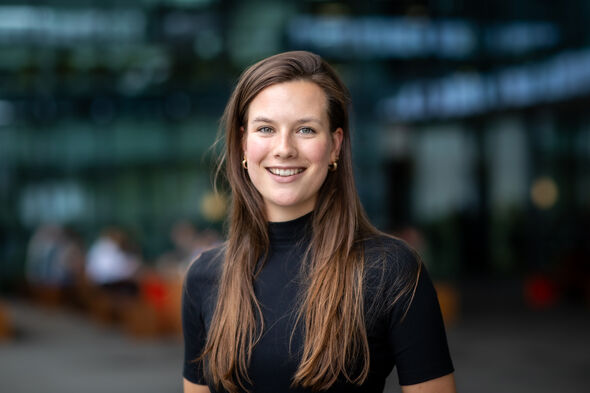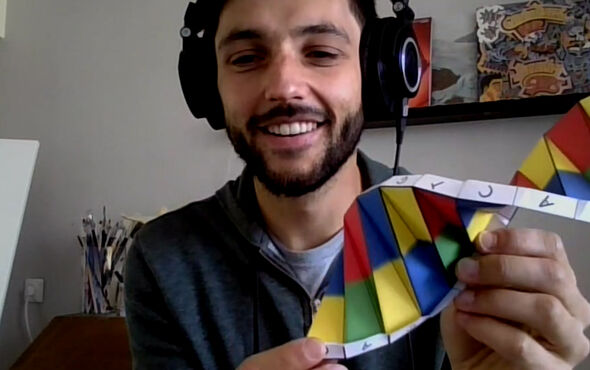Wokkels and ‘cellfies’: how to explain your research to children?
Stimulating the human body's capacity for self-repair at cellular level, or the point of ‘folding’ DNA… How do you explain to children what your research involves? PhD Maritza Rovers and postdoc Bas Rosier, both researchers at the Department of Biomedical Engineering, will be staging an attempt this coming Friday at Expedition NEXT, a science festival for children, to be held in Franeker.
People are not like lizards or starfish, which grow back a lost tail or limb. But in the lab run by Full Professor Patricia Dankers researchers are working on ways to help the human body repair itself. Not when a limb is lost, but when an organ has a problem.
They are developing nanomaterials on which cells like to grow – both within and outside the body – as a way of forming new organ tissue made from the body's own material. PhD Maritza Rovers is one of these researchers. Together with her colleagues Dan Jing Wu and Simone de Jong, later this week she is traveling to the province of Friesland. There, on Friday May 6th, in the former university city of Franeker, a science festival, Expedition NEXT, is being held.
Lab coat
“In my doctoral research I am developing gelatinous nanostructures in which we can cultivate cells outside the body. To be honest, I don't think my parents know exactly what I'm doing,” says Rovers, laughing. How will she convey her work clearly to an audience aged from six to twelve on Friday?
Continue reading below the photo
“We'll translate it to something that they already know, hence the comparison with the lizard that can regrow its tail. And we'll start with the basics: that our bodies are made up of billions of cells. Cells that are so small you can't see them, but they are there, all the same.”
Under a microscope, the young visitors will be able to look at cells taken from the mucous membrane that lines the inside of their own mouths. “They'll get a photo of the cells to take home: a ‘cellfie’,” says Rovers. To make the whole experience as ‘real’ as possible, the threesome will be taking along all kinds of materials from the lab, “And the visitors will get to wear a lab coat and safety goggles.”
Fireflies
For Bas Rosier, Expedition NEXT is one his of last activities as an academic researcher; in a couple of weeks' time, he will be leaving Maarten Merkx's group, where he has been a postdoc, in order to join a company that is marketing new medicines. “A fitting finale: it gives me a chance to make sure someone takes my place,” he says, with a wink.
As a postdoc, Rosier is working to produce molecules that can act as a biosensor. “They manage this using something called bioluminescence, the principle that fireflies and the sea sparkle also use. They emit green light that becomes blue in the presence of the substance they are designed to detect.”
In Franeker, the subject Rosier will be talking about, however, is the substance of his doctoral study, which he also did at TU/e: DNA. “I was working on DNA origami, where we reprogram DNA so that we can fold nanostructures from it very precisely. This is with the goal of placing enzymes on them at very precise intervals, enabling them to work together.”
Continue reading below the photo
Coriander
There are two things Rosier would like to convey to the festival's visitors. “Firstly, what DNA is and how much influence it has on the way we look, our behavior and our health. And secondly, that scientists are normal, fun people, and you can ask them anything!”
At times, he himself still feels like a child. “I still marvel the world in the same way I did as a kid, and I want to know how everything works. A couple of years ago I was also at Expedition NEXT, and I discovered that if I can connect with children on that level, it's really easy to interact with them.”
To stimulate the curiosity of the young visitors, Rosier is taking a table-load of odd, seemingly random items to Friesland. “Like a coriander plant. Are you someone who finds the taste of coriander unpleasant? I think it tastes like soap. This is because the plant contains a lot of aldehydes, substances that are also found in detergent. But thanks to a DNA mutation, there are more and more people who do like the taste.”
Grocery list
Also standing on the table is a bird – “a plastic crow, the kind you buy in a garden center to scare off pigeons” – because a similar thing has happened with birds: thanks to a change in their DNA, they can no longer taste the sharpness of pepper, which means they can eat the fruits of pepper plants and thus spread the seeds.
Visitors will also be able quite literally to do origami with DNA: using worksheets, they will have the chance to build the double helix of our genetic code, copying its original folds. “And then I'll be able to use that to explain a whole lot more,” says Rosier, who has a sudden inspiration for his grocery list. “Talking of helices, I mustn't forget to buy a couple of bags of Wokkels. I'll have to put a bowlful on the table, won't I!”
![[Translate to English:]](/fileadmin/_processed_/f/4/csm_ExpNEXTKids-sfeerfoto2_0cecec74e0.png)




Discussion